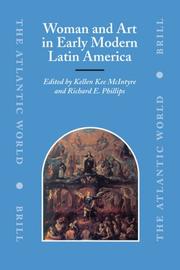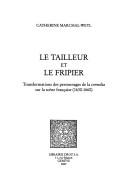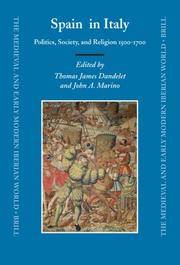| Listing 1 - 4 of 4 |
Sort by
|

ISBN: 9004153926 9786611400613 1281400610 9047410998 9789047410997 9789047410997 9789004153929 Year: 2007 Publisher: Leiden Boston Brill
Abstract | Keywords | Export | Availability | Bookmark
 Loading...
Loading...Choose an application
- Reference Manager
- EndNote
- RefWorks (Direct export to RefWorks)
This anthology centers on the visual representation of woman in early modern Latin America, that is, the social and cultural construction and definition of female identity as evidenced by the art document. Artists in this period were collectively aware of a vocabulary of gender that could be tailored to deliver varying messages about the position of women in vice regal culture and society. This volume is organized not in the predictable linear framework, by periods and centuries, but rather by the realization that throughout much of this period, Spanish authorities and others envisaged the Spanish colonies of the Americas in gendered terms. Proffered as the female body, the “New” (virginal by implication) World was at differing times adored, pursued, courted, seduced, defiled, exploited, reviled, and denounced by those (males) who encountered “her.” This mentality is born out in the various forms of female representation that are discussed in this fully illustrated book. Contributors include: C. Cody Barteet, María Elena Bernal-García, Magali M. Carrera, Carol E. Damian, Carolyn Dean, Catherine R. DiCesare, Lori Boornazian Diel, Kelly Donahue-Wallace, Ray Hernandez-Duran, Andrea Lepage, Kellen Kee McIntyre, Penny Morrill, Elizabeth Q. Perry, Richard E. Phillips, Michael J. Schreffler, and Christopher C. Wilson. ERRATUM TO CHAPTER 7 Ray Hernández-Durán, “ El Encuentro de Cortés y Moctezuma : The Betrothal of Two Worlds in Eighteenth-Century New Spain” (pp. 181–206). On page 194, second paragraph, third sentence, should read: “Marina’s absence in the encounter painting, where she normally mediates contact between the men, emphasizes the phallogocentric aspect of the historic meeting.” The original phrasing, using the pivotal term, ‘phallogocentric’ (a reference to a gendered form of exchange or communication) was changed to ‘phallus-centered,’ which not only alters a central idea in the argument, but actually has nothing to do with the image in question.
Women in art. --- Art, Latin American --- Art, Spanish American --- Latin American art --- Spanish influences.

ISBN: 9782600010924 2600010920 Year: 2007 Volume: 29 Publisher: Genève : Droz,
Abstract | Keywords | Export | Availability | Bookmark
 Loading...
Loading...Choose an application
- Reference Manager
- EndNote
- RefWorks (Direct export to RefWorks)
Les imitations françaises du théâtre hispanique du Siècle d'Or connurent, entre 1630 et 1660, un épanouissement paradoxal compte tenu de leurs divergences esthétiques respectives. Brossant le contexte culturel dans lequel s'inscrit ce mouvement d'imitation et rappelant les caractéristiques de la comedia, Catherine Marchal-Weyl étudie les personnages dans les tragi-comédies et comédies de trois auteurs en l'occurrence représentatifs : Rotrou, Boisrobert et Scarron. Les transformations dont ils affectent leurs modèles soulignent que leur intérêt tient à l'exaltation des valeurs nobiliaires, à travers une dramaturgie des fausses apparences construite autour du déguisement d'identité. L'adaptation de la comedia en dénature ainsi la structure, modifiant l'équilibre des personnages, qui tendent à devenir des caractères. Enfin sont mises en évidence l'évolution et les constantes d'une vague d'adaptations qui nourrit, sur les plans structurel et thématique, le renouvellement du théâtre français du premier XVIIe siècle, et dont l'examen permet de dégager des préceptes de bienséance et de vraisemblance, communs aux deux théâtres, des conceptions opposées de l'illusion dramatique.
French drama --- French drama (Comedy) --- Spanish drama --- Spanish drama (Comedy) --- History and criticism. --- Spanish influences. --- French drama - 17th century - History and criticism. --- French drama (Comedy) - Spanish influences. --- Spanish drama - Classical period, 1500-1700 - History and criticism. --- Spanish drama (Comedy) - History and criticism.

ISBN: 9004154299 9789004154292 9786611400798 1281400793 9047411188 9789047411185 9781281400796 6611400796 Year: 2007 Volume: 32 Publisher: Leiden Brill
Abstract | Keywords | Export | Availability | Bookmark
 Loading...
Loading...Choose an application
- Reference Manager
- EndNote
- RefWorks (Direct export to RefWorks)
Nuanced understanding of the reciprocal nature of Spanish-Italian relations and the rich cultural production that was the product of the far-reaching exchanges between the two peninsulas throughout the early modern period guides the nineteen essays in this volume. The key political reality of sixteenth and seventeenth-century Spanish imperial domination in Italy—formal (Sicily, Sardinia, Naples, Milan), informal (Rome, Genoa, Tuscany), and more neutral or independent (Venice)—introduces the investigation in this volume into the methods and mechanisms of control and collaboration, cooperation and cooptation, assimilation and resistance. The connections between topics and problems in social, administrative, economic, and cultural history follow from political theory and practice. Politics, society, economy, and religion help us see both Spain and Italy more clearly.
Italy --- Spain --- History --- Social conditions --- Relations --- Civilization --- Spanish influences. --- Espanja --- Spanien --- Hiszpania --- Spanish State --- España --- Estado Español --- Espagne --- Hispania --- Sefarad --- Sepharad --- Shpanye --- Shpanie --- Reino de España --- Kingdom of Spain --- Reino d'Espanya --- Reinu d'España --- Espainiako Erresuma --- Regne d'Espanya --- Reiaume d'Espanha --- Espanya --- Espanha --- スペイン --- Supein --- イスパニア --- Isupania --- Repubblica italiana (1946- ) --- Italian Republic (1946- ) --- Włochy --- Regno d'Italia (1861-1946) --- Iṭalyah --- Italia --- Italie --- Italien --- Italii︠a︡ --- Kgl. Italienische Regierung --- Königliche Italienische Regierung --- إيطاليا --- Īṭāliyā --- جمهورية الإيطالية --- Jumhūrīyah al-Īṭālīyah --- Італія --- Італьянская Рэспубліка --- Italʹi︠a︡nskai︠a︡ Rėspublika --- Италия --- Италианска република --- Italianska republika --- Ιταλία --- Ιταλική Δημοκρατία --- Italikē Dēmokratia --- 이탈리아 --- It'allia --- 이탈리아 공화국 --- It'allia Konghwaguk --- איטליה --- רפובליקה האיטלקית --- Republiḳah ha-Iṭalḳit --- Lýðveldið Ítalía --- Itālija --- Itālijas Republika --- Italijos Respublika --- Olaszország --- Olasz Köztársaság --- イタリア --- Itaria --- イタリア共和国 --- Itaria Kyōwakoku --- Italiya Respublikasi --- Италия Республикаси --- Italii︠a︡ Respublikasi --- Итальянская Республика --- Італійська Республіка --- Italiĭsʹka Respublika --- İtalya --- İtalya Cumhuriyeti --- איטאליע --- Iṭalye --- 意大利 --- Yidali --- 意大利共和国 --- Yidali Gongheguo --- Laško --- Sardinia (Italy) --- Італійська Республіка
Book
ISBN: 9788322928776 Year: 2007 Publisher: Wroclaw : Wydawnictwo Uniwersytetu Wroclawskiego,
Abstract | Keywords | Export | Availability | Bookmark
 Loading...
Loading...Choose an application
- Reference Manager
- EndNote
- RefWorks (Direct export to RefWorks)
Polish literature --- Spanish literature --- Spanish influences --- Polish influences --- Sawicki, Piotr. --- Poland --- Spain --- Espanja --- Spanien --- Hiszpania --- Spanish State --- España --- Estado Español --- Espagne --- Hispania --- Sefarad --- Sepharad --- Shpanye --- Shpanie --- Reino de España --- Kingdom of Spain --- Reino d'Espanya --- Reinu d'España --- Espainiako Erresuma --- Regne d'Espanya --- Reiaume d'Espanha --- Espanya --- Espanha --- スペイン --- Supein --- イスパニア --- Isupania --- Poyln --- Polska Rzeczpospolita Ludowa --- Polʹsha --- P.N.R. --- P.R.L. --- Pologne --- Polish Commonwealth --- Polonia --- Warsaw (Duchy) --- Polska --- Polsko --- T︠S︡arstvo Polʹskoe --- Królestwo Polskie --- Polʹskai︠a︡ Narodnai︠a︡ Respublika --- PNR --- PRL --- Poljska --- Lehastan --- Polin --- Būlūniyā --- Polonyah --- République populaire de Pologne --- Polen --- Ppolsŭkka --- Polish People's Republic --- Republic of Poland --- Poland (Territory under German occupation, 1939-1945) --- Generalgouvernement (Poland) --- Generalne Gubernatorstwo (Poland) --- General Government (Poland) --- Heneralʹna Hubernii︠a︡ (Poland) --- Rzeczpospolita Polska --- Polish Republic --- Congress Kingdom of Poland --- Congress Poland --- Królestwo Kongresowe Polskie --- Kongresówka --- Kingdom of Poland --- Lahistān --- لهستان --- Lithuania (Grand Duchy) --- Relations --- Polandia --- Полшэ --- Polshė --- Pole --- Republiek van Pole --- Republik Pole --- Polaland --- Polisce Cynewise --- Полша --- Полониа --- بولندا --- Būlandā --- Polóña --- Tavakuairetã Polóña --- Польша --- Puluña --- Ripublika Puluña --- Polşa --- Polşa Respublikası --- Pulandia --- Ripublik Pulandia --- Pho-lân --- Pho-lân Kiōng-hô-kok --- Польшча --- Polʹshcha --- Рэспубліка Польшча --- Rėspublika Polʹshcha --- Polonya --- Република Полша --- Republika Polsha --- Poin --- Republika Poljska --- Польшо --- Polʹsho --- Bu̇gėdė Naĭramdakha Polʹsho Ulas --- Polská republika --- Polaki --- Gwlad Pwyl --- Gweriniaeth Gwlad Pwyl --- Republikken Polen --- Republik Polen --- Poola --- Poola Vabariik --- Πολωνία --- Pulógna --- Польша Мастор --- Polʹsha Mastor --- República de Polonia --- Pollando --- Respubliko Pollando --- Repúbrica de Poloña --- Poloniako Errepublika --- Pólland --- République de Pologne --- Poalen --- Poloonya --- Polonie --- An Pholainn --- Pholainn --- Poblacht na Polainne --- Yn Pholynn --- Pholynn --- Pobblaght ny Polynn --- A' Phòlainn --- Poblachd na Pòlainn --- Borandi --- Pô-làn --- Польшин Орн --- Polʹshin Orn --- 폴란드 --- P'ollandŭ --- Pōlani --- Lehastani Hanrapetutʻyun --- Польшæ --- Polʹshæ --- Польшæйы Республикæ --- Polʹshæĭy Respublikæ --- IPoland --- IPolandi --- Lýðveldið Pólland --- Repubblica di Polonia --- פולין --- רפובליקת פולין --- Republiḳat Polin --- Poleni --- Kunngiitsuuffik Poleni --- Pòlskô Repùblika --- Poloni --- Polonye --- Polòy --- Puoleja --- Puolejis Republika --- Polija --- Polijas Republika --- Lenkija --- Lenkijos Respublika --- Polsca --- Republica de Polsca --- Pol'šu --- Polskas --- Bupoolo --- Bupolska --- Ripablik kya Bupoolo --- Lengyelország --- Lengyel Köztársaság --- Polish-Lithuanian Commonwealth --- Crown of the Kingdom of Poland and the Grand Duchy of Lithuania --- Commonwealth of Poland --- Heneralʹna hubernii︠a︡ (Poland) --- General Government for Occupied Polish Territories
| Listing 1 - 4 of 4 |
Sort by
|

 Search
Search Feedback
Feedback About UniCat
About UniCat  Help
Help News
News